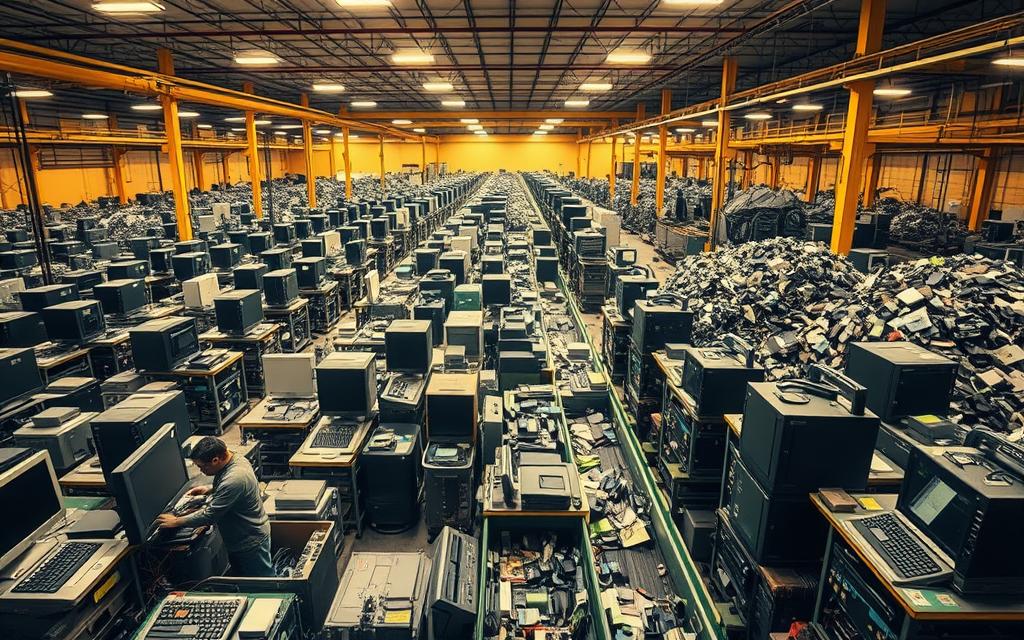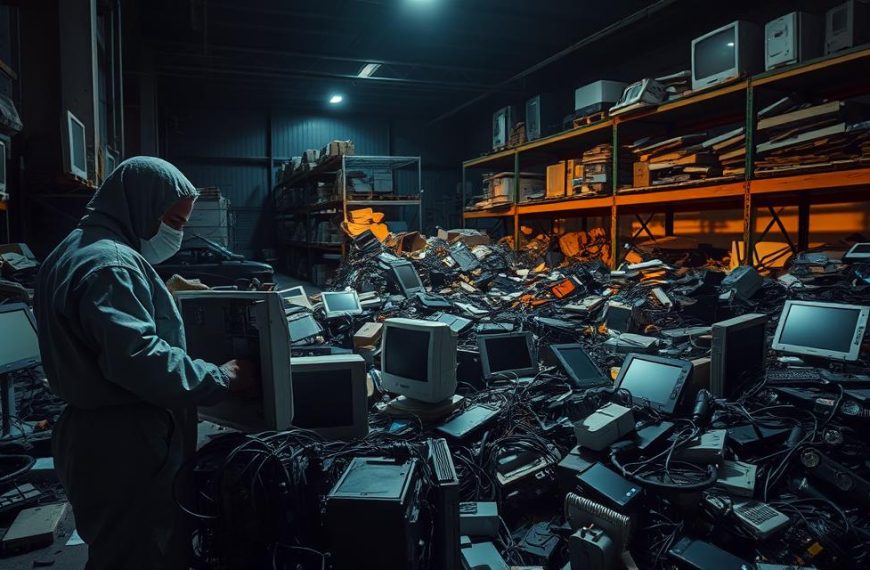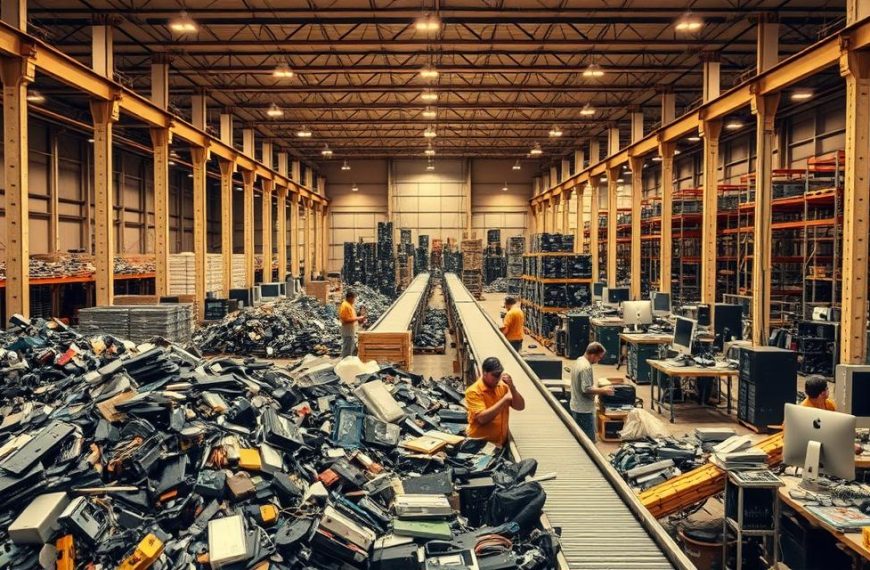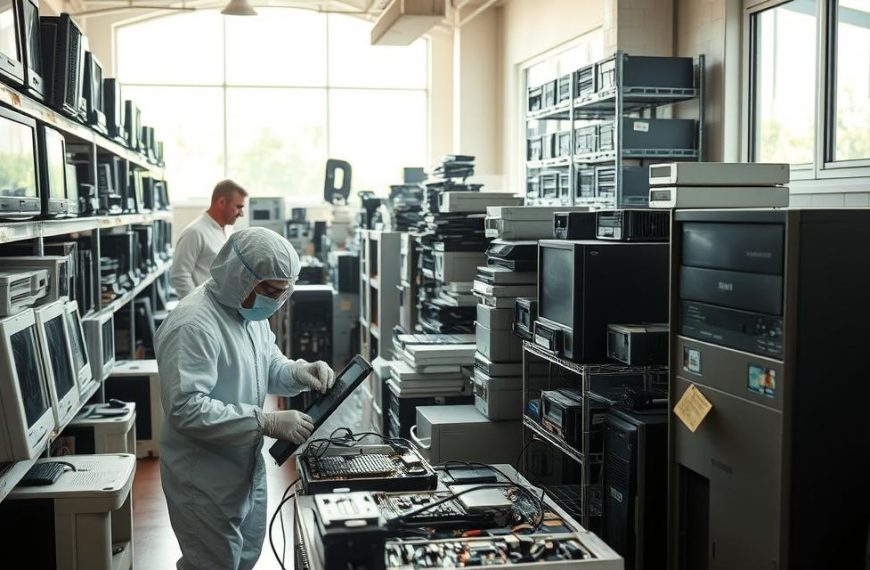When your computer is no longer useful, it’s important to dispose of it properly. Many people don’t know the harm of throwing electronics in regular bins.
Not recycling electronics can harm the environment and put your data at risk. Toxic materials can pollute soil and water. Your personal info could also be exposed on old devices.
This guide helps you find trusted computer recycling services near you. We’ll show you how to spot certified centres that protect the environment and destroy your data safely.
Choosing the right way to get rid of your old electronics is key. It keeps our planet safe and protects your privacy. Let’s look at the best ways to manage electronic waste responsibly.
The Importance of Recycling Your Personal Computer
Personal computers are now a big part of our lives. But, they become outdated quickly, posing a big environmental problem. It’s important to dispose of them responsibly to protect our planet and save resources.
The Rising Tide of Electronic Waste
The amount of electronic waste worldwide is growing fast. New tech and shorter product lives add to this problem. Computers are a big part of this waste, holding valuable materials and harmful parts.
Companies that deal with e-waste follow strict rules to handle it safely. They make sure materials are collected and processed right. This helps solve the environmental issues caused by bad waste management.
Choosing the right recycling centres has many benefits:
- Resource conservation: Getting metals back reduces mining needs
- Environmental protection: Safe handling stops pollution from harmful metals
- Economic benefits: It supports a green economy and new business models
Professional e-waste services handle toxic materials like lead and mercury safely. This stops them from harming our soil and water.
| Recycling Benefit | Environmental Impact | Economic Value |
|---|---|---|
| Metal Recovery | Reduces mining operations | Creates raw material supply |
| Toxic Material Management | Prevents soil contamination | Avoids cleanup costs |
| Energy Conservation | Lowers carbon footprint | Reduces manufacturing costs |
| Component Reuse | Minimises waste generation | Supports affordable computing |
Proper e-waste disposal is more than just protecting the environment. It’s our duty to handle technology’s growth in a green way. By picking certified recycling, we help a system that values both new tech and caring for our planet.
Recycling centres use advanced methods to get the most from materials while keeping harm low. They know how to handle every part of your computer, whether it’s reused, recycled, or disposed of safely.
Understanding E-Waste and Its Environmental Consequences
Digital technology has grown fast, leading to a big problem with old electronics. Devices get outdated quickly, making electronic waste a huge issue. We need to act fast to manage this waste responsibly.
Defining Electronic Waste
Electronic waste, or e-waste, includes old electrical and electronic items. This includes computers, monitors, printers, phones, and their accessories like keyboards and cables.
It’s key to know the difference between e-waste and other electrical items. Computers and their parts are e-waste, but things like kettles are not.
Risks Associated with Incorrect E-Waste Handling
Throwing away electronics the wrong way harms the environment and our health. When e-waste goes to the wrong places, it can pollute soil and water. This is why we need electronic recycling centres for safe disposal.
Old electronics have toxic stuff like lead and mercury. If they leak into water, they can harm people’s health. This is a big problem for communities near bad disposal sites.
Some places burn e-waste to get metals, which pollutes the air. This harms workers and people living nearby.
The table below shows what’s in e-waste and how it can harm the environment if not disposed of right:
| Electronic Component | Hazardous Materials | Environmental Impact | Proper Disposal Method |
|---|---|---|---|
| Computer Monitors | Lead, Mercury | Groundwater contamination | Specialised recycling facilities |
| Circuit Boards | Lead, Cadmium | Soil pollution | Certified e-waste processors |
| Batteries | Lithium, Acid | Chemical leaching | Battery collection programmes |
| Plastic Casings | Brominated Flame Retardants | Toxic fume release when burned | Dedicated recycling streams |
Badly managing e-waste hurts the environment in many ways. It wastes valuable resources and energy. We must recycle properly to avoid this.
Professional recycling centres use safe methods to get metals and dispose of harmful parts. This way, we protect the environment and save resources.
How to Find PC Recycling Near Me
Finding local e-waste recycling options requires online research and talking to local groups. This method helps you find the best way to recycle old computers in your area.
Leveraging Online Resources for Local Searches
The internet has great tools to find recycling facilities fast. Websites and databases list approved e-waste centres in the United States.
Top Websites to Locate Recycling Centres
Online platforms make finding places to dispose of computers easy. Earth911 has a big database for searching by material and zip code. The EPA website gives tips on recycling electronics and lists certified recyclers.
Manufacturer sites like Dell, HP, and Apple have recycling locators. Local government websites often have waste management info, including collection events and drop-off spots.
Check the facility’s hours and what they accept before you go. Calling ahead ensures they take your computer and tells you about any costs.
Engaging with Local Councils and Environmental Groups
Talking to local groups can reveal more recycling options. Government offices and environmental groups often have e-waste events or work with recyclers.
Effective Communication Strategies
When you contact local groups, have specific questions ready. Ask about what they accept, preparation needs, and how they protect your data.
Find out about collection events, drop-off spots, and if they pick up big items. Knowing about fees and standards ensures your computer is recycled right.
Building relationships with these groups can lead to more recycling options. Many communities have groups dedicated to e-waste recycling who are eager to help.
Don’t give up if one contact can’t help. They might know someone who can. This way, you might find recycling options not listed online.
Steps to Prepare Your PC for Recycling
Before recycling your computer, it’s important to prepare it properly. This ensures your personal data stays safe and the equipment is handled correctly. The process includes two main steps: removing all data and physically preparing the device.
Securing and Erasing Personal Data
Even after deleting files or formatting, your personal data can remain on storage drives. This makes identity theft a risk if the wrong people get their hands on it. Always remember that complete data destruction is your job before recycling.
Detailed Guide to Data Wiping
There are several ways to remove data permanently. Choose the method that fits your comfort level and security needs.
- Software wiping tools: Programs like DBAN (Darik’s Boot and Nuke) overwrite your drive with random data. This meets government data sanitisation standards.
- Built-in operating system tools: Windows’ “Reset this PC” and macOS’s Disk Utility secure erase are solid built-in options.
- Professional data destruction service: For businesses or sensitive data, certified pros use top-grade equipment and provide destruction proof.
- Physical destruction: As a last resort, shredding or drilling drives ensures total data security.
Just moving files to the recycling bin doesn’t delete them. For SSDs, follow the manufacturer’s guidelines as some need special care.
Disassembling and Sorting Components
Some recycling programs accept whole systems, while others want parts separated. If you decide to take apart your PC, follow these tips for safety and efficiency.
Essential Safety Measures
Computer parts need careful handling due to their materials. These steps protect you and the environment.
- Power disconnection: Unplug all cables and press the power button to discharge electricity
- Electrostatic discharge (ESD) protection: Use an anti-static wrist strap and work on non-carpeted surfaces
- Proper tools: Use the right screwdrivers to avoid damage or injury
- Component identification: Separate metals, plastics, and circuit boards for better recycling
- Hazardous material handling: Batteries and capacitors need special care – put them in separate containers
If you’re not sure about disassembling, many recycling centers accept whole systems. They handle separation professionally. The main thing is to keep your data safe throughout the recycling process.
Exploring Various Recycling Programmes and Facilities
Looking for ways to recycle electronics? You’ll find many options. These include corporate schemes and community efforts. Each has its own benefits for different needs.
Retailer and Manufacturer Initiatives
Big electronics companies now have recycling plans. These show they care about the environment and make recycling easy for you.
A manufacturer takeback programme lets you bring back old items when buying new. Some shops also let you drop off items without buying anything.
Specific Programmes: Best Buy Recycling, Dell Reconnect
Best Buy Recycling offers free drop-off for most electronics at their stores in the US. They take computers, monitors, and more, but some items might cost a bit to recycle.
Dell Reconnect works with Goodwill to recycle at many places across the country. It accepts any computer brand, not just Dell, making it easy for everyone.
“Responsible recycling starts with manufacturers taking care of their products from start to finish.”
These schemes usually protect your data, but always check their data wiping policies first.
Community and Government-Led Options
There are also local recycling efforts. These focus on helping residents without needing to buy anything.
Local councils often have special days for recycling electronics. These ensure safe handling and keep harmful materials out of landfills.
Identifying Local Collection Events
To find a community e-waste event, check your local council’s website or environmental department. Many areas have yearly or quarterly events for electronics.
Environmental groups often help with these events. They offer free drop-off and make sure materials are handled properly.
| Programme Type | Accessibility | Cost Structure | Data Security |
|---|---|---|---|
| Retailer Programmes | Nationwide locations | Often free with purchase | Professional wiping services |
| Manufacturer Takeback | Mail-in or drop-off | Typically free | Varies by programme |
| Community Events | Localised availability | Usually completely free | Self-handling required |
When picking a recycling option, think about what you need. Look at convenience, cost, and data protection. Many places now offer different ways to recycle electronics responsibly.
Conclusion
Proper PC recycling tackles the growing problem of electronic waste. It keeps our environment safe from harmful toxins. It also makes sure your personal data stays private.
Finding places to recycle e-waste is easier than you think. Online tools and community programmes help a lot. Retailers like Best Buy and companies like Dell offer take-back services.
Your actions help create a greener future. Recycling computers reduces landfill waste and saves resources. Always choose certified recycling facilities for your peace of mind.
Start by finding a trusted e-waste centre near you today. Dispose of your old electronics with confidence. Your efforts make a big difference in managing electronic waste responsibly.











